Energy & Power Systems > Completed Projects
Completed Projects
Testing Electric Pressure Cooker adoption in Socio-economic and Cultural Context of Nepal
Fuelwood continues to be the primary cooking fuel in Nepal, followed by imported liquefied petroleum gas (LPG). Nearly 73.5% of the households depend on fuelwood for cooking, and only 26.3% of households were using LPG. Nepal has 42 GW, technically and economically viable, hydro generation potential. Affordable and uninterrupted access to grid electricity, for a significant part of the day, is available to 71.7% of households, making it an ideal country to explore the viability of electric cooking adoption. A study in 2019 reported that both men and women in Nepal highlighted the electric rice cooker’s positive impacts.
A multi-disciplinary consortium consisting of Indian and Nepalese non-government organisations (IRADe and WACN) proposes this community-scale pilot study to examine the socio-economic and cultural acceptability and financial viability of Electric Pressure Cooker (EPC) adoption in Nepal. The study aims to accelerate the uptake of EPC in Nepal and has identified the following broad objectives:
(i) Providing EPC intervention to members of women communities in rural and urban locations of Kavrepalanchok district,
(ii) collecting data about cooking practices for intervened households using a localised version of the MECS e-cooking diary to understand communities willingness and challenges to adopting EPC and related behavioural changes,
(iii) organising a workshop to bring together policymakers, women groups, electric cooking appliance supplier/manufacturer, civil societies, researchers and users to inform study findings for accelerating EPC adoption in Nepal and
(iv) Translate these findings of electric cooking to international funding agencies for scaling-up this study in South Asian countries.
Supported By: Loughborough University, the U.K. under the programme Modern Energy Cooking Services –Electric Cooking Outreach (MECS-ECO)
Impact Assessment of Electricity Access on Health and Education
The main goal of this study is to assess the status of the electricity access at government-run PHCs and schools and its impact on health and education outcomes, in rural and peri-urban areas. The study will bring out the status of electricity supply at PHCs and schools in terms of availability, reliability, quality, convenience and usage. Leveraging benefits of stable electricity access, for better health and education services, itself requires enabling infrastructure and equipment available in PHCs and schools. Therefore, the proposed study will also use a list of “tracer indicators” to gauge the presence or absence of key infrastructure and instruments at the PHCs and schools. This study will assess whether a facility has grid access, a portable generator or a solar power source, and frequency of power interruptions. Following are the objectives of this study:
- To assess the electricity supply at PHCs and government schools using multi-tier framework (MTF) of energy access.
- To study the reasons for non-electrification of PHCs and school, if any.
- To assess the service readiness of PHCs and government schools in terms of infrastructure and equipment’s availability.
- To assess the impact of electricity access in PHCs on health care service delivery; patients and staff satisfaction.
- To assess the impact of electricity access in schools on educational service delivery; students, and staff satisfaction.
The main outcomes of the project are provided below:
- Improved policy support at the state and national levels so that energy planning, policy development and implementation takes into account the needs of health and education centres in peri-urban and rural areas.
- Enhanced awareness among the policymakers, health and education sector professionals, NGOs and people at large.
- Strengthened reliable supply of electricity through evidence-based required local needs and opportunities.
- Improved service delivery by PHC’s and schools.
Sponsored by: SHAKTI Sustainable Energy Foundation
EV Charging Patterns and Impact on Discom
Electricity Distribution Companies (DISCOMs) will play a major role as facilitators for EV integration. The impact of EVs on the supply side of DISCOMs need to be carefully assessed in view of the impact on their daily Demand Load Factor and Distribution Transformer (DT) level loading. The objective of this study is to assess the existing EV user profiles, their charging patterns and develop a format to enable distribution utilities to estimate the demand at the DT level through a case study on specific localities of Delhi.
The surveys will help to understand the existing EV users’ behaviour. Further, this will also help us to understand the possibility of different types of charging and locations for different modes of EVs. This will be a key to suggest mode wise (i.e. e-rickshaws, electric 2W & 4W) charging behaviour and needs of EVs users for Delhi. Further, this project will provide a clear insight to the decision-makers, planning agencies and Discoms, on the present and future scenarios of EVs in Delhi, charging pattern and distributed transformer (DT) level electricity demand etc. Three key aspects of the project are mentioned below:
- Primary Surveys and Key Stakeholder Engagement.
- Assessment of EV Penetration through Scenario-based assessment and Charging Strategy.
- Assessment of EV impact on Local Grid and DT level.
Long Term Strategy for Low Carbon Development
This project is a subgrant to IRADe by CSTEP for providing them outputs of various economic sectors which are drivers of energy demand for their project titled “Long Term Strategy for Low Carbon Development” funded by MOEFCC. In this project, IRADe team has been asked to provide outputs of sectors which are energy demand drivers like transport, Cement, Iron& Steel, Mining & Quarrying, Agro-Processing, Textiles, Fertilizers, Agriculture, Buildings for four scenarios
Supported By: Ministry of Environment, Forest and Climate Change (MoEFCC)
Soft Landings for Indian Renewable Integration through Balancing Technologies
This project is a sub grant to IRADe by The Asia Foundation for raising the pitch on the subject of storage technologies in India, and their necessity in enabling integration of further renewable energy generation in the Indian grid. Considering the large capacity of renewables ultimately to be integrated, it is essential that adequate balancing sources, including storage energy devices, be deployed in the grid to smoothen the variability of renewable generation like wind and solar power.
The first roundtable was on 27 March 2019 at India Habitat Centre, New Delhi, with experts from think tanks, working in the energy space, participating in the discussions. The roundtable had a presentation via video call from Australian National University about their pumped hydro energy storage (PHES) project site atlas. Inputs received from this shall be taken forward for deliberations in the next year as part of the project. Various representatives from the Ministry of Power attended the roundtable.
Supported By: The Asia Foundation
Implications of declining costs of Solar, Wind and Storage Technologies on regional power trade in South Asia (BBIN Countries)
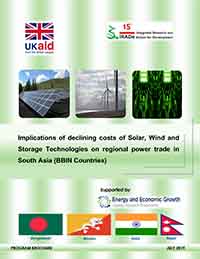 IRADe will carry out research for EEG Energy and Economic Growth (EEG) to undertake a modelling study on the implications of declining Solar, Wind and Storage Technologies on regional power trade in South Asia particularly in the Bangladesh, Bhutan, India and Nepal (BBIN Countries). To capture this technology cost decline impact in South Asia region, we will develop a regional electricity model that will comprise of reference energy system focusing on electricity capacity addition in Bangladesh, Bhutan, India and Nepal using the bottom up technology-based TIMES (The Integrated MARKAL-EFOM System) model generator. The regional electricity model will be run with various scenario assumptions with cost decline for solar, wind and storages technologies. This scenario-based assessment will help in answering the following questions in South Asia:
IRADe will carry out research for EEG Energy and Economic Growth (EEG) to undertake a modelling study on the implications of declining Solar, Wind and Storage Technologies on regional power trade in South Asia particularly in the Bangladesh, Bhutan, India and Nepal (BBIN Countries). To capture this technology cost decline impact in South Asia region, we will develop a regional electricity model that will comprise of reference energy system focusing on electricity capacity addition in Bangladesh, Bhutan, India and Nepal using the bottom up technology-based TIMES (The Integrated MARKAL-EFOM System) model generator. The regional electricity model will be run with various scenario assumptions with cost decline for solar, wind and storages technologies. This scenario-based assessment will help in answering the following questions in South Asia:
- What will the impact of the declining cost of solar, wind and storage technologies on the regional power trade? Impact on annual quantum, seasonality and hourly trade volumes?
- What will be the implication on regional hydro potential utilization? How much of flexible hydro is utilized in the region for balancing renewables with declining storage cost?
- What will be the capacity of transmission network required?
- Possible capacity mix in the region? Fuel consumption by the power sector in the region?
- What will be the environmental benefits in terms of lower CO2 emissions?
For this, the project, Dr. Jyoti Parikh (Executive Director, IRADe) participated at the event “Green grids: connecting Asia” from 28 to 30 March 2019 at Wilton Park, United Kingdom, (https://www.wiltonpark.org.uk/event/wp1656/) wherein she gave a talk on ‘Opportunities and Challenges for cross border electricity trade’. She also introduced the audience with the EEG project’s goals and expected outputs in the South Asia region.
https://energyeconomicgrowth.org/
Supported by: Energy and Economic Growth (EEG )
Study to Develop a roadmap for implementation of India’s NDC goal 3
In the Paris Conference of Parties (COP) as a part of its Nationally d=Determined Contributions (NDCs) India has committed to reduce emissions intensity by 33-35% by 2030 compared to 2005, have 40% of power generation capacity from non-fossil fuel sources and increased forest cover to increase carbon sequestration by 3 mt of CO2 eq. The study assessed current policies for each the sector which may reduce emissions intensity and calculated the additional change in the policies if any and factors to achieve NDC Goal 3 of emissions intensity reduction at the national level. In the process, the study intends to calculate the financial cost for implementing current policies and also for the incremental effort to implement NDC Goal 3.
Supported By: Ministry of Environment, Forest and Climate Change (MoEFCC)
Partnerships for Skill Development LCEDN Program
There is overwhelming evidence that access to modern energy forms is critical to development. The UN SDG 7 aims to ensure universal access to affordable, reliable and sustainable energy services by 2030. Access to clean energy improves living standards, improves economic opportunity, and can contribute to better health, education and overall wellbeing. Despite these benefits, many regions of the world, including India, experience high levels of energy poverty and inequitable access to clean energy resources. In response, large numbers of government mandates, civil society groups, industries and research organisations have committed to developing and researching clean energy solutions.
In India, women and girls are often the primary producers and users of household energy, but there has been a lack of dialogue about the ways in which energy poverty impacts women, and the role of energy access programmes in facilitating empowerment in line with UN SDG 5. On this background, IRADe along with TERI and MSSRF, in partnership with ENERGIA started a series of workshop to be held in Delhi, Chennai and Bangalore. The workshop aims to directly address these topics, with the goal of providing a platform for conversation on the household energy-empowerment nexus to national and international participants working in the field of gender and energy sectors. It will facilitate opportunities for discussion between participants in understanding how clean energy programmes impact the welfare, productivity and empowerment of women and girls within low-income households in India. In bringing together a diverse range of participants, the workshop aims to contribute to building a network of gender and energy in India, on a cross-disciplinary platform to learn.
Supported By: Loughborough University
Electricity as a clean cooking option for rapid scale cooking option
IRADe has been awarded this work by NABARD (National Bank for Agriculture and Rural Development) to explore the possibilities of using electric cooking as a way for providing clean cooking access to rural-peri-urban areas. Under this project IRADe would work in Rajasthan and Chhattisgarh states to carry out the study with field level surveys and technology demonstration and monitoring of the household that would be provided with electric induction cookers. The study will help to understand consumer/stakeholder behaviour towards the new technology/device, cooking habits and reasons for its adoption or otherwise. The project will involve a multi stakeholder approach to address all the issues and will work with petroleum, renewable and electricity departments and ministries. The project will help in meeting the UN’s SDG’s of clean energy accesses and gender issues and suggest suitable policy issues to reach the goals effectively.
Supported by: National Bank For Agriculture And Rural Development (NABARD) , Government of India
Ajmer Solar City Master Plan
IRADe is preparing the Ajmer Solar City master plan for Ajmer Municipal Corporation, Rajasthan under the Solar City Programme of MNRE and Smart City. Urbanization and economic development are leading to a rapid rise in energy demand in urban areas leading to enhanced Green House Gas (GHG) emissions. The program aims at minimum 10% reduction in projected demand of conventional energy at the end of five years, which can be achieved through a combination of energy efficiency measures and enhancing supply from renewable energy sources.
The solar city master plan of the city will include the base line for energy consumption during the baseline year, demand forecasting for the next five years, sector-wise strategies and action plan for implementation of renewable energy projects like solar, wind, biomass, small hydro, waste to energy etc. may be installed along with possible energy efficiency measures depending on the need and resource availability in the Ajmer city, so as to mitigate the fossil fuel consumption in the city and reduce the Green House Gas (GHG) emissions.
Supported by: Ajmer Municipal Corporation, Government of Rajasthan
Udaipur Solar City Master Plan 
IRADe prepared Udaipur Solar City master plan for Udaipur Municipal Corporation under the Udaipur Smart city with the guidelines of Solar City Programme of MNRE. Urbanization and economic development are leading to a rapid rise in energy demand in urban areas leading to enhanced Green House Gas (GHG) emissions. The program aims at minimum 10% reduction in projected demand of conventional energy at the end of five years, which can be achieved through a combination of energy efficiency measures and enhancing supply from renewable energy sources.
The solar city master plan of the city include the base line for energy consumption during the baseline year2015, demand forecasting for the next five years, sector-wise strategies and action plan for implementation of renewable energy projects like solar, wind, biomass, small hydro, waste to energy etc. may be installed along with possible energy efficiency measures depending on the need and resource availability in the Udaipur city, so as to mitigate the fossil fuel consumption in the city and reduce the Green House Gas (GHG) emissions.
IRADe had submitted the final report to Udaipur Municipal Corporation.
Supported by: Udaipur Municipal Corporation, Government of Rajasthan
Global Technology Watch Group (GTWG) on Advanced Coal Technologies (ACT) for Power Generation
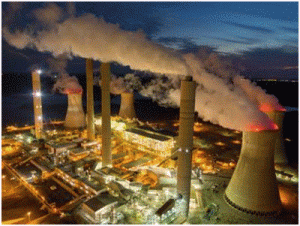
IRADe is a member of the Global Technology Watch Group, a consortia comprising of three IIT’s (Madras, Bombay and Delhi) for the continuous monitoring of the status of coal technologies in India and abroad, their evaluation for use in India, and to facilitate the development of a road map of Advanced Coal Technologies for Sustainable Power Generation.
Coal will be the fuel of the country for several more decades. The present coal technologies are of low efficiency and highly polluting. Highly efficient, eco-friendly, economically viable ACT need to be developed and deployed at the earliest. The existing non-technological barriers like isolated and fragmented research and development, lack of effective collaborative research and focused team work can be overcome by establishing a national ACT network which will bring together stakeholders from industry-academia-government-society to encourage, facilitate, catalyse and actuate purposeful sharing of knowledge and resources at national and international levels. This will help in creating a coal database, facilitate the development of a coal road map and culminate in the creation of a Global ACT Network, for the benefit of coal power generation in the country.
IRADe would critically examine the various technologies in power generation, beneficiation and mining and would develop a technology index based on multiple evaluation criteria such as capital cost, O&M cost, CO2 & other emissions, socio-economic and water food print evaluation.Some technologies that are already in various stages of development but yet to be evaluated are ultra super critical power plants and Integrated Gasification Combined Cycle (IGCC). Technology literature reviews for coal power generation, sustainability assessment and have developed a draft matrix for sustainability analysis.
Under the project IRADe has participated in three meetings at IIT-Madras, IIT-Bombay and IIT-Delhi along with participation in many related workshops and conferences.
Supported by Ministry of Science & Technology,
Department of Science & Technology, Government of India
Environmentally Sustainable and Integrated Energy Strategies for Gujarat
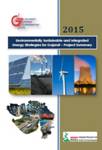 e prepared a strategy document on “Environmentally Sustainable and Integrated Energy Strategies for Gujarat”, supported by Gujarat Power Corporation Limited (GPCL). Under the project, the socio-economic aspects, energy and environment profile of the state are studied to calculate the energy demand for the next two decades.
e prepared a strategy document on “Environmentally Sustainable and Integrated Energy Strategies for Gujarat”, supported by Gujarat Power Corporation Limited (GPCL). Under the project, the socio-economic aspects, energy and environment profile of the state are studied to calculate the energy demand for the next two decades.Based on current energy scene, energy requirements were worked out for a number of scenarios of economic growth and structure of the economy and technology. While exploring supply strategies the following factors are taken into account, energy imports, conservation, energy access to consumers at affordable cost, infrastructure needed, energy pricing and emissions. Energy-mix needed for meeting out the energy demand is detailed along with energy supply strategies for 2035.
Under the project IRADe had 3 high level stakeholder consultation meetings at Gandhi Nagar to take the views of all the concerned energy and power sector professionals from Central and State Government and Private Sector Operators.
Supported by
Gujarat Energy & Petrochemicals Department & Gujarat Power Corporation Limited (GPCL)
Download Report
Analysis of Kerosene-free Delhi Scheme
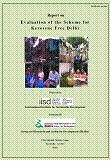 Kerosene-free Delhi’ (KFD) scheme was launched by the Delhi Government in 2012. It gave a free LPG cylinder, a two- burner gas stove, regulator and gas pipe to ration card holders using kerosene. IRADe found the scheme to be reasonably successful as it reduced indoor air pollution but, at the same time, it failed to include the poor as it focused only on the holders of ration cards, thus excluding the others, i.e. the homeless with no identity card or address. It was also found that some kerosene use continued to bridge days between the order and delivery of a gas cylinder. IRADe recommended supply of 5 kg cylinders. The government has recently announced that supply of 5 kg cylinders will be increased.
Kerosene-free Delhi’ (KFD) scheme was launched by the Delhi Government in 2012. It gave a free LPG cylinder, a two- burner gas stove, regulator and gas pipe to ration card holders using kerosene. IRADe found the scheme to be reasonably successful as it reduced indoor air pollution but, at the same time, it failed to include the poor as it focused only on the holders of ration cards, thus excluding the others, i.e. the homeless with no identity card or address. It was also found that some kerosene use continued to bridge days between the order and delivery of a gas cylinder. IRADe recommended supply of 5 kg cylinders. The government has recently announced that supply of 5 kg cylinders will be increased.
Sponsored by
International Institute for Sustainable Development (IISD)
Download Report
Assessing the Impacts of Diesel Subsidy Reform since January 2013
 Diesel accounted for 39.55% out of total petroleum products consumption in India in 2012-13 (Energy Statistics 2014). This makes diesel an important petroleum product whose consumption and pricing has major macro economic implications. The study “Assessing the Impacts of Diesel subsidy reform since January 2013” by IRADe critically evaluates how the diesel price reforms impacted the important stake holders in the economy. The annual diesel consumption shows a negative growth rate for the first time in last five decades in 2013-14. As per IRADe findings, decontrol of diesel prices resulted in overall increase in WPI (Wholesale Price Index) inflation but it has turned out to be temporary in nature. The elasticity of overall wholesale price inflation with respect to diesel price change is quite lower. The wholesale price of food is largely influenced by rainfall, seasonal impacts and market forces and diesel price change has a very small impact on it. IRADe’s Analysis shows that the persistent CPI inflation is because of hike in food prices and not because of diesel prices. In the report we conclude that when CPI inflation is controlled, the RBI is likely to respond by reducing the real interest rate which will stimulate economic growth and reap the benefits of diesel reforms.
Diesel accounted for 39.55% out of total petroleum products consumption in India in 2012-13 (Energy Statistics 2014). This makes diesel an important petroleum product whose consumption and pricing has major macro economic implications. The study “Assessing the Impacts of Diesel subsidy reform since January 2013” by IRADe critically evaluates how the diesel price reforms impacted the important stake holders in the economy. The annual diesel consumption shows a negative growth rate for the first time in last five decades in 2013-14. As per IRADe findings, decontrol of diesel prices resulted in overall increase in WPI (Wholesale Price Index) inflation but it has turned out to be temporary in nature. The elasticity of overall wholesale price inflation with respect to diesel price change is quite lower. The wholesale price of food is largely influenced by rainfall, seasonal impacts and market forces and diesel price change has a very small impact on it. IRADe’s Analysis shows that the persistent CPI inflation is because of hike in food prices and not because of diesel prices. In the report we conclude that when CPI inflation is controlled, the RBI is likely to respond by reducing the real interest rate which will stimulate economic growth and reap the benefits of diesel reforms.
This Project is supported by International Institute for Sustainable Development (IISD).
The Impacts of India’s Diesel Price Reforms on the Trucking Industry
“The Impacts of India’s Diesel Price Reforms on the Trucking Industry” evaluates the impact of higher diesel prices on India’s road freight transport sector.
The report finds that the trucking industry is vulnerable to higher fuel costs, and supports the earlier evidence that the fuel costs account for around 55 per cent of their total operating costs. However, the main finding of the study is that the industry’s weakness is primarily grounded in structural constraints that have squeezed profit margins, while providing truckers with little leverage to pass on higher costs to clients. The study suggests that addressing these constraints—more so than subsidizing the cost of fuel—is the solution to the long-term profitability of the industry.
The industry suffers from oversupply due to the lack of training stipulations, relaxed registration requirements and easy financing. Eighty per cent of truck operators are small truckers who own less than five trucks. Such small operators cannot reap the benefits of economies of scale and cannot afford to obtain the necessary business information and are thereby dependent on brokers.
Due to oversupply of trucks and fierce competition, freight rates are mostly determined by demand for trucking and thus, increased fuel costs have little influence on them. But fuel costs being around 55 per cent of the total operating costs, truck operators are vulnerable to increased diesel price.
A substantial amount of evidence suggests that a reduction in diesel under-recoveries will have significant fiscal and economic benefits to India’s economy as a whole. However, higher prices will negatively affect industry and diesel-intensive sectors—of which the trucking industry is one of the most obvious.
Supported by the International Institute for Sustainable Development (IISD)
Taming Diesel Subsidy to Curtail Inflation and Foster Economic Growth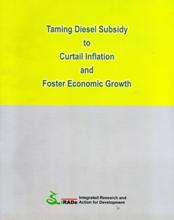
Government is reluctant to raise diesel price fully for fear that it might lead to inflation, even though administered price of petroleum products leads to large under-recoveries. Partial financing of under-recoveries by the government is done by direct budgetary support and indirectly by the Public sector oil marketing companies (OMCs) and upstream oil companies (ONGC and OIL). These high levels of under-recoveries raise the fiscal deficit, which in turn leads to higher money supply resulting in higher inflation prompting Reserve Bank to raise interest rate that lowers investment and economic growth rate over time. While steps have been taken by the government to decontrol prices of petrol, LPG and kerosene, diesel continues to be heavily subsidized, as a change in status quo may lead to inflation in the short term. To explore this trade-off between short term impact and medium term outcomes, IRADe has conducted a study titled ‘Taming Diesel Subsidy to Curtail Inflation and Foster Economic Growth’. The aim of the study is to assess the alternative road maps for diesel price reform in India.
Key findings are:
- Continuing with present policy of subsidizing diesel price is not tenable. This could have very large economic costs in the long term.
- Full increase, which is a one shot increase of 30%, in the diesel price leads to some immediate increase in inflation; however, continuing with present subsidy involves a much higher rate of inflation later and which persists over a longer time. The average inflation rate over 3 years will be 6.6 percent if diesel price is decontrolled but would be 9% if diesel subsidy continues. Such high overall inflation hurts the poor even more than the increase in diesel price.
- The trade-off between short term negative impacts and long term benefits is not just with inflation, but also for GDP. The growth rate would be 8% with price decontrol and only 6.5%, if we continue with the present policy. The loss in GDP will hurt poor whether they use diesel or not.
Sponsored by Shakti Sustainable Energy Foundation and the Ministry of Finance.
Overview and Assessment of Indian Renewable Energy and Rural Electrification
Programme in the Context of Rural Development:
This inception study on Renewable Energy Component of the Indo-German Energy Programme gives an overview and assessment of the National and State policies to promote renewable energies, rural electrification and relevant issues in rural development. Along with it the relevant institutions and stakeholders of the GOI programmes, were covered that are to guide energy investment in this sector.
Sponsored by GTZ-German Technical Corporation.
Indian Renewable Energy Status Report – Background Report for DIREC 2010
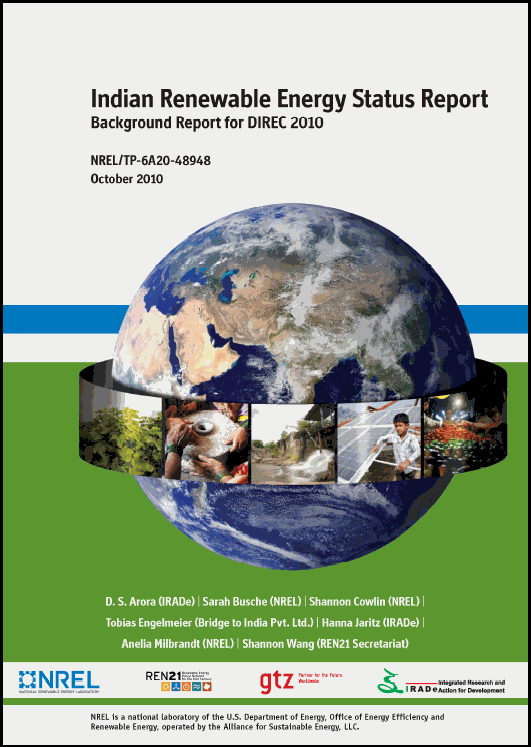 The “Indian Renewable Energy Status Report” was considered as a background report for the DIREC (Delhi International Renewable Energy Conference) 2010 on behalf of the “Renewable Energy Policy Network for the 21st Century – REN21”. Basis of this report was a study from the German Technical Cooperation (GTZ) for the German Federal Ministry for Environment, Natural Conservation and Nuclear Safety (BMU). In addition to GTZ the report was produced with the collaboration of experts from the U.S. Department of Energy’s National Renewable Energy Laboratory (NREL), REN21 and BRIDGE TO INDIA Pvt. Ltd.
The “Indian Renewable Energy Status Report” was considered as a background report for the DIREC (Delhi International Renewable Energy Conference) 2010 on behalf of the “Renewable Energy Policy Network for the 21st Century – REN21”. Basis of this report was a study from the German Technical Cooperation (GTZ) for the German Federal Ministry for Environment, Natural Conservation and Nuclear Safety (BMU). In addition to GTZ the report was produced with the collaboration of experts from the U.S. Department of Energy’s National Renewable Energy Laboratory (NREL), REN21 and BRIDGE TO INDIA Pvt. Ltd.
Sponsored by: Deutsche Gesellschaft fuer Internationale Zusamenarbeit (GIZ, formerly GTZ –
German Technical Cooperation) www.giz.de
The report gives a comprehensive review of the Indian Energy and Renewable Energy Status in general, followed by an extensive look into the renewable energy sources like wind, solar, small hydro and biomass. These chapters include topics on estimated resource potential, existing installation rate, policies, investment flows and industrial trends in India. Furthermore the report covers the potentials of renewable energy for India to provide access to remote, unelectrified populations and ended with the discussion of technology transfer and the status of financing of renewable energy technologies in India.
Analysis of Carbon Capture and Storage (CCS) technology in the Power Sector in India 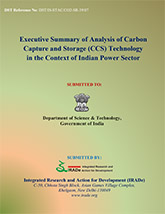
In the study of CCS technology in relation to India’s Power Sector, IRADe projected emissions of CO2 from power plants in future, carried out literature survey to identify developments in carbon capture technology and evaluated each technology for its economical and technical viability. Specification of sequestration sites, identification of the way forward for development, evaluation of monitoring options of CCS, regulatory issues were discussed . The study provides an opportunity for policy makers to engage in debates. The study recommended that the impact of CCS on the cost of power generation should be assessed with various options to define appropriate technology and costs under Indian conditions.
Sponsored by The Department of Science and Technology, (GoI).
Identifying Specific Policy Options with the Aim of Reducing Carbon Intensity in India
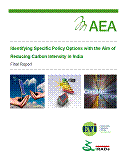
Government of India has announced the National Action Plan on Climate Change (NAPCC) and its constituent eight missions prepared under the aegis of the Prime Minister’s Council and furthermore, an ‘Expert Group on Low Carbon Strategies for Inclusive Growth’ chaired by Dr. Kirit Parikh, has been set up to provide technical and policy options to reduce 20-25% emission intensity by 2020. Various other countries are aggressively pursuing low carbon growth plans, and by rapidly disseminating the lessons globally learned in implementing low carbon growth plans and particularly from UK/EU experience and applying them to the challenges faced in India, India may be able to leapfrog these experiences and accelerate the implementation of policies that are a deviation from the business as a usual scenario. Under this context, the aim of this study project was to provide practical recommendations on low carbon policy options to support the ‘Expert Group on Low Carbon Strategies for Inclusive Growth’ appointed by the Planning Commission to reduce India’s emission intensity. The study aims to provide practical recommendations for the policy landscape in India, specifically in three key domains identified by stakeholders: Renewable Energy Certificates (RECs), Green/Energy Efficient Buildings and Low Carbon Institutional Framework. The study ‘Identifying specific policy options with the aim of reducing carbon intensity in India’ is undertaken by AEA, Emergent Ventures India and IRADe, and is supported by the British High Commission.
Key Recommendations
Renewable Energy Certificates (RECs):
- Ensuring policy certainty and regulatory compliance by demonstrating a national policy commitment for RECs by setting appropriate targets that aligns with the national level targets of renewable energy generation.
- Setting uniform RPO targets across states in India , set Minimum Price guarantee for RECs and strengthening the penalty mechanism
Green and energy efficient building standards:
- Promote the uptake of green and energy efficient building standards by incentivising owners and developers to overcome barriers related to capital intensity, high cost and general reluctance to move from existing practice. Central financial assistance could be provided to city municipalities and other local bodies to finance these incentives.
- Reduce the knowledge gaps and promote greater sharing of information amongst technical experts and developers to incorporate Green building/ energy efficiency techniques in building design and construction.
- Stricter regulatory provisions and mandating standards for making designers and contractors for rapid adoption of techniques and technologies for green and energy efficient buildings.
Low carbon governance and institutional framework:
- A special unit such as the Low Carbon Growth Unit (LCGU) could be set up in planning commission to focus expressly on delivery of those aspects of the 5-Year Plan with climate elements linked to the NAPCC.
- A new dedicated committee was established by the Prime Minister, under the PM Council, to track the progress of the NAPCC Missions with clear recommendations of what improvements can be made.
- Improving the institutional framework to support private sector action
Indian Perspectives on Global Energy Scenarios till 2050
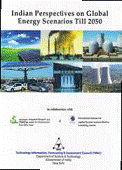 TIFAC supported a collaborative project with International Institute for Applied Systems Analysis (IIASA), Austria. The objective was to understand energy transition needed in India that is consistent with global perceptions and to identify research and development required for the transition. IRADe studied IIASA’s energy scenarios for global regions from India’s perspectives. The project provided a global energy vision for India till 2050.
TIFAC supported a collaborative project with International Institute for Applied Systems Analysis (IIASA), Austria. The objective was to understand energy transition needed in India that is consistent with global perceptions and to identify research and development required for the transition. IRADe studied IIASA’s energy scenarios for global regions from India’s perspectives. The project provided a global energy vision for India till 2050.
In IIASA’s scenario, carbon capture and storage (CCS) played an important role. IRADe scenario without CCS pushed more nuclear and gas plants along with renewables. IRADe’s work with IIASA helped identify technologies for the energy transition needed for sustainable development including for combating climate change. It also helped India to present its perspective in the development of global energy scenarios that reflects India’s concerns.
Sponsored by
Technology Information, Forecasting and Assessment Council (TIFAC)
Evaluation of impact of RGGVY and issues in implementation of RGGVY
Under the project, IRADe was to study in five states – Assam, Gujarat, Himachal Pradesh, Rajasthan and Uttar Pradesh – the progress of village electrification in terms of coverage and quality of coverage (such as infrastructure, electrification of Below Poverty Line (BPL) households, etc.). One of the main objectives is to list various Governments and their agencies responsible for various tasks for successful implementation of RGGVY projects and comment on the efficiency in fulfilling those responsibilities. IRADe studied 25 districts and 125 villages i.e. five districts in each state and five villages in each district. Implementation issues for RGGVY were discussed with various government agencies, Discoms, district officials, village panchayats and households. We found that good quality rural electricity distribution infrastructure was built and positive socio-economic impact was observed. Also, while BPL consumers benefited, there was a need for wider acceptance by Above Poverty Line (APL) households to receive and pay for electricity for better utilization of the distribution network and its economic viability. The next phase of the programme should address these issues. scheme, ‘electrified’
Sponsored by
Rural Electrification of India (REC), Government of India
Executive Summary of RGGVY Evaluation of Rajasthan, Assam, Gujarat, Himachal Pradesh and Uttar Pradesh
Download Report
Integrated Executive Summary of RGGVY evaluation of Rajasthan, Assam, Gujarat, Himachal Pradesh and Uttar Pradesh
Download Report
Monitoring and Evaluation of Off-Grid Solar Photovoltaic Systems Installed in Punjab and Himachal Pradesh in the Years 2008, 2009 and 2010
Ministry of New and Renewable Energy (MNRE) is implementing a country-wide Solar Photovoltaic programme (SPV) of demonstration and promotion of solar photovoltaic lighting systems, stand-alone power plants and other new and specialized systems in the country. The evaluation was conducted through surveys of beneficiaries and discussions with the officials of MNRE and state nodal agencies (PEDA of Punjab and Himurja of Himachal Pradesh). It was found that a large percentage of systems installed were working.
Supported by
Ministry of New and Renewable Energy, Government of India
Evaluation of Franchise System in Assam, West Bengal, Nagaland and Rajasthan
The Ministry of Power (MoP) had awarded a study to IRADe to assess franchise systems in Assam, Nagaland and West Bengal. Rural Electricity Corporation (REC) awarded further studies to IRADe for evaluating the franchise systems operating in different district distribution circles in Assam, West Bengal, Nagaland and Rajasthan through sample villages in these states. This project covered villages in Bankura and Dibrugarh districts in West Bengal & Assam and the REC project survey included villages in Purulia, Jodhpur and New Bongaingaon districts. Conclusions were drawn from the studies that franchises require adequate supply of good-quality power maintained by utilities to work effectively. Also capacity building of franchises should be done at the beginning.
Supported by
Ministry of Power, Government of India
Evaluation of Solar Thermal Demonstration Projects in Four States of India
The MNRE had provided solar cookers and solar water heaters to the residents of villages in four states namely Rajasthan, Haryana, Uttarakhand and Gujarat. Overall, the users of solar thermal products were satisfied. 90 per cent of the users felt that food cooked with solar cookers tasted better and was healthier. They were happy that the solar cooker does not require fuel and needed little maintenance. They were aware that these products had a long operational life, but could only be used during the day, and their effectiveness depended on the season.
Supported by
Ministry of New and Renewable Energy, Government of India
Evaluation of Solar Photovoltaic Programme in Six States of India
The MNRE had provided village residents in six states, namely Rajasthan, Haryana, Uttarakhand, Gujarat, Manipur and Karnataka, with solar technologies such as home lighting systems, water pumps, lanterns and street light systems. Evaluation done by IRADe for MNRE through the field visits focused on verification and collection of beneficiary level information regarding functioning and maintenance of the solar systems and satisfaction level of beneficiaries. Their lifestyles have changed gradually following work done under the scheme. The benefits accrued were increased working hours for useful tasks, increased study hours of children, decline in consumption of kerosene and decline in environmental accidents such as snake and insect bites. Beneficiaries have started using mobile phones, radios, telephones etc.
Supported by
Ministry of New and Renewable Energy, Government of India
Survey and Evaluation of Remote Village Area Electrification Project through Solar Photovoltaic System in Rajasthan and Haryana
The MNRE had provided subsidy for solar homelighting and street-light systems to residents in the remote villages of India, which could not be covered by the national power grid. In the survey done by IRADe for MNRE, it was observed that a target-oriented approach was followed during its implementation. The implementing agencies did not fully adhere to the guidelines stipulated by MNRE. Approximately 15 per cent of the systems were found to be non-functional. Improvements in maintenance and service support from equipment suppliers are needed.
Supported by
Ministry of New and Renewable Energy, Government of India
Village Energy Security Programme in Vavdi and Vaddithar Hamlets in Patan District of Gujarat
Village Energy Security programme in Vavdi and Vaddithar in Patan District of Gujarat is a part of the Village Energy Security Programme under Remote Village Electrification programme of the MNRE. IRADe installed biogas plants, improved stoves, wood gasifier based electricity generator and jatropha plantation for biodiesel in two villages, Vavdi and Vaddithar of Santalpur Taluka of Patan district of Gujarat. IRADe in close cooperation with the Self-Employed Women’s Association (SEWA), Gujarat Energy Development Agency (GEDA), the village Panchayat and village population implemented the programme that aimed to provide access to electricity through biomass resources to households in remote villages which are not likely to be covered through grid extension.
Biodigesters were set up in both the villages to provide lighting to 50 homes. Secretary, MNRE Mr. V. Subramaniam dedicated it to Vavdi village. 100 improved cook stoves were also distributed in each village at subsidized rates. Self-help groups were formed and were given electric flour mills, soap making units, etc., for income generation.
Supported by
Ministry of New and Renewable Energy, Government of India
Rural Microenterprise Model for Biofuel Extraction in India
IRADe formulated a microenterprise model for biomass-based energy system at the village level. The objective was to extract oil that provides an alternative source of fuel in rural areas. IRADe set up a biodiesel extrusion unit in Bawal, Rewari district of Haryana. The villagers were explained how to use the extraction machine and get biodiesel.
Supported by
Sustainable Energy Project Support (SEPS) of WISIONS,Germany
Natural Gas Demand by Indian Fertilizer Sector
Natural gas is the preferred feedstock for urea manufacture. The demand for natural gas for the next two decades was projected for the fertilizer sector. These projections were made in the context of changing government policies regarding the fertilizer industry, such as farm gate price regulation and self-sufficiency level of indigenous urea production. The current growth plan of natural gas supply and evolving supply scenario in the future were also considered in the study. Depending on the price of urea the need for natural gas was projected to be between 27 BCM and 34 BCM for 2025–26.
Supported by
Programme on Energy & Sustainable Development (PESD) of Stanford University, USA
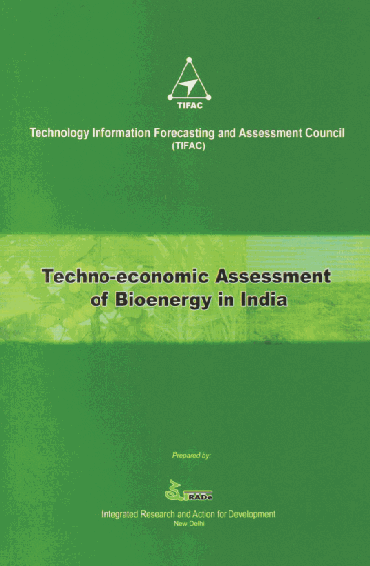
Techno-Economic Assessment for Bio-energy in India : ” The study reflects on various issues of bio-energy in India and identifies prioritized investment opportunities for technology development and its market adaptation under appropriate policies. The study found that among various bio energy options in India, biodiesel, bio ethanol and biomass gasification are found to be most relevant areas, where investments for technology and marketing development could be made. Wastelands could be used for growing oil seed plants for producing biodiesel, irrigated land for sugarcane based ethanol production and small plots in village location be used for producing fuel wood for gasification. Thus their land requirements are complementary, though they do compete with other uses.
Sponsored by Technology Information Forecasting and Assessment Council (TIFAC)
Impact of Fuel Scarcity and Pollution on Rural Poor, 2004 Himachal Pradesh 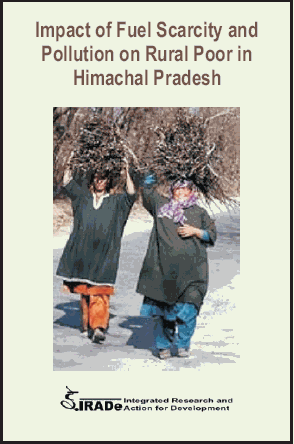
The project was funded by Global Development Network (GDN)
through its regional working group (SANEI) South Asian Network, New Delhi. The research project assessed the impact of scarcity of clean fuels and traditional fuels. It assessed in economic terms the impact of pollution from the use of traditional bio-fuels on vulnerable groups of rural poor in Himachal Pradesh in the context of their socio-economic circumstances, access to fuel, needs and willingness to pay for cleaner fuels. The key results included the household energy consumption pattern, cooking behavior, health profile, analysis of vulnerable groups and toll on human resources, which showed that about 21% of rural adults, might be having some respiratory symptoms.
Integrated Analysis of Diesel Substitutes from Oil Seeds for India:
This study reviewed the entire mechanism, beginning from an overview of the best biodiesel tree plantation practices extraction and processing of oil and finally the end uses of the product. A policy framework for land availability for oil seeds plantation, minimum support price for seeds, subsidies for farmers for raising plantations, tax exemption for entrepreneurs and sale of biodiesel is suggested. Institutional mechanisms for raising nursery and plantation and for carrying out R&D are also required. Financial incentives could be provided to oil companies as they will ensure quality oil and take various types of risks. An action plan to reduce cost of production, increase financial viability and market linkages was also discussed for biodiesel production.
Sponsored by Petroleum Federation of India (PetroFed), New Delhi
Fuelling India’s growth vision 2030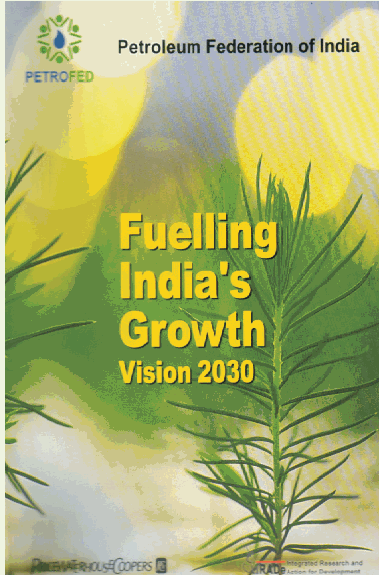
This is a part of the continuing initiative of the Petroleum Federation of India to enhance awareness about the petroleum sector and current issues concerning it and associated industry in India. Integrated Research and Action for Development (IRADe) assisted PwC in undertaking the econometric modelling and projections for the study.
PROJECT RELATED WORKSHOPS
- Workshop on Carbon Capture and storage (CCS) in Power sector in India, 22-23 January 2008, New Delhi, supported by Department for Environment, Food and Rural Affairs (DEFRA), UK and The British High Commission New Delhi
- IRADe-SANEI dissemination workshop on Impact of fuel scarcity and pollution on Rural poor: A comparative analysis of vulnerable groups in Himachal Pradesh, India international Centre, New Delhi, March 11 , 2005, supported by Global Development Network (GDN) /South Asian Network, (SANEI) New Delhi
- International Conference on A Global Green New Deal? – Towards Green Energy Policies for Sustainable Development September 24-25, 2010. Sponsor: Friedrich Ebert Stiftung (Foundation).
